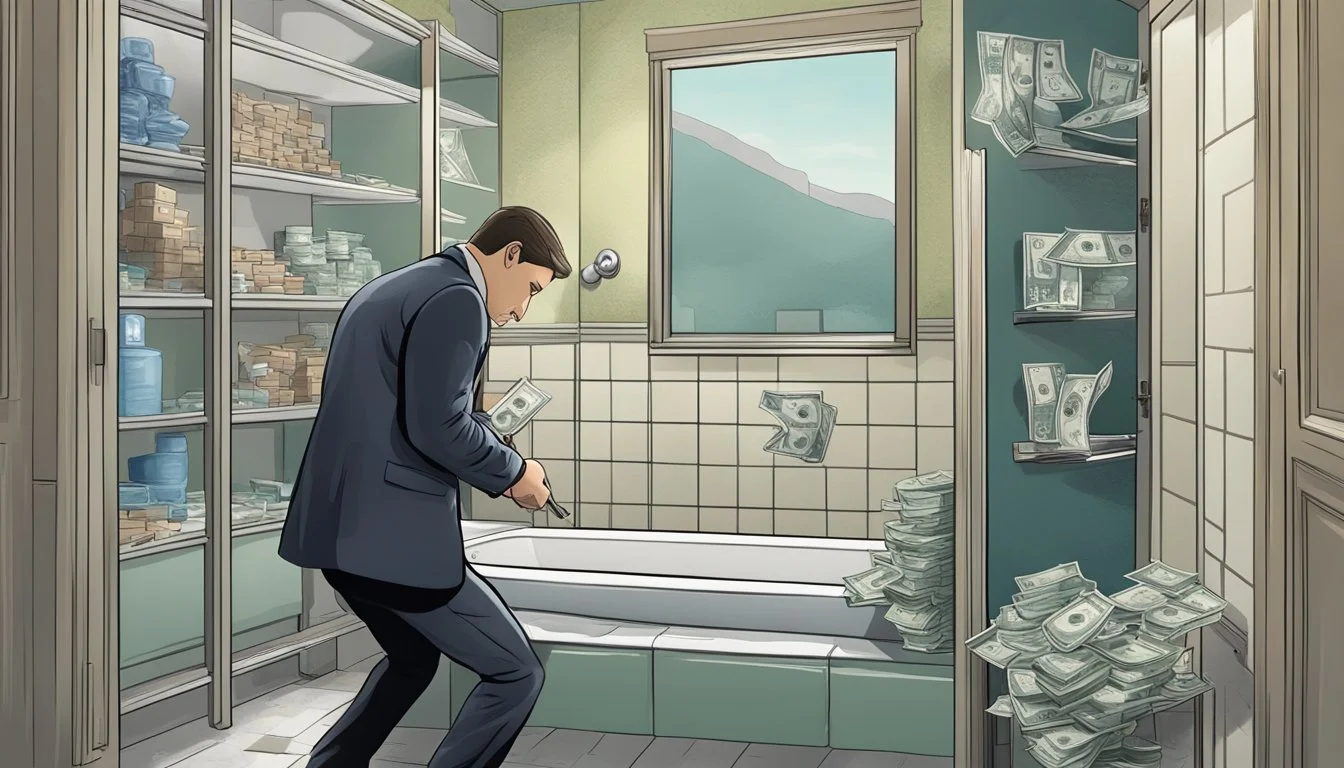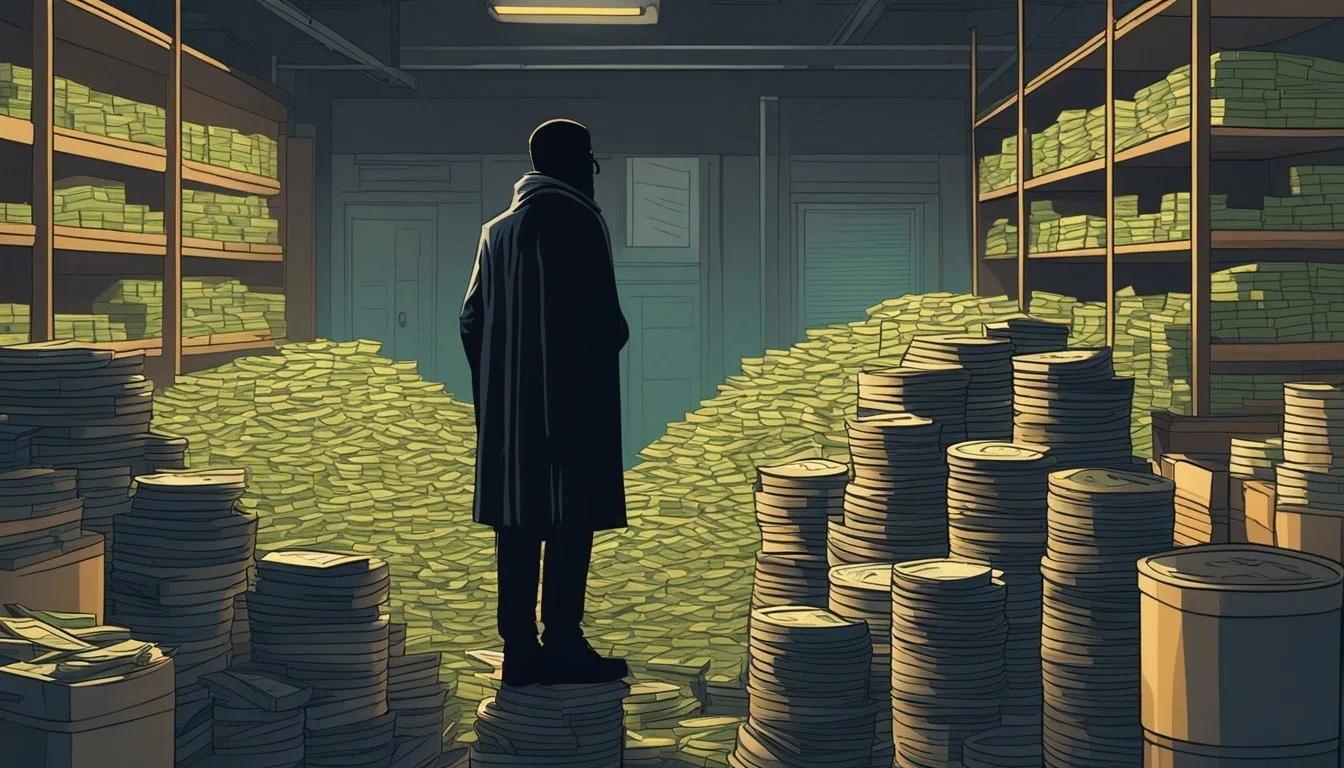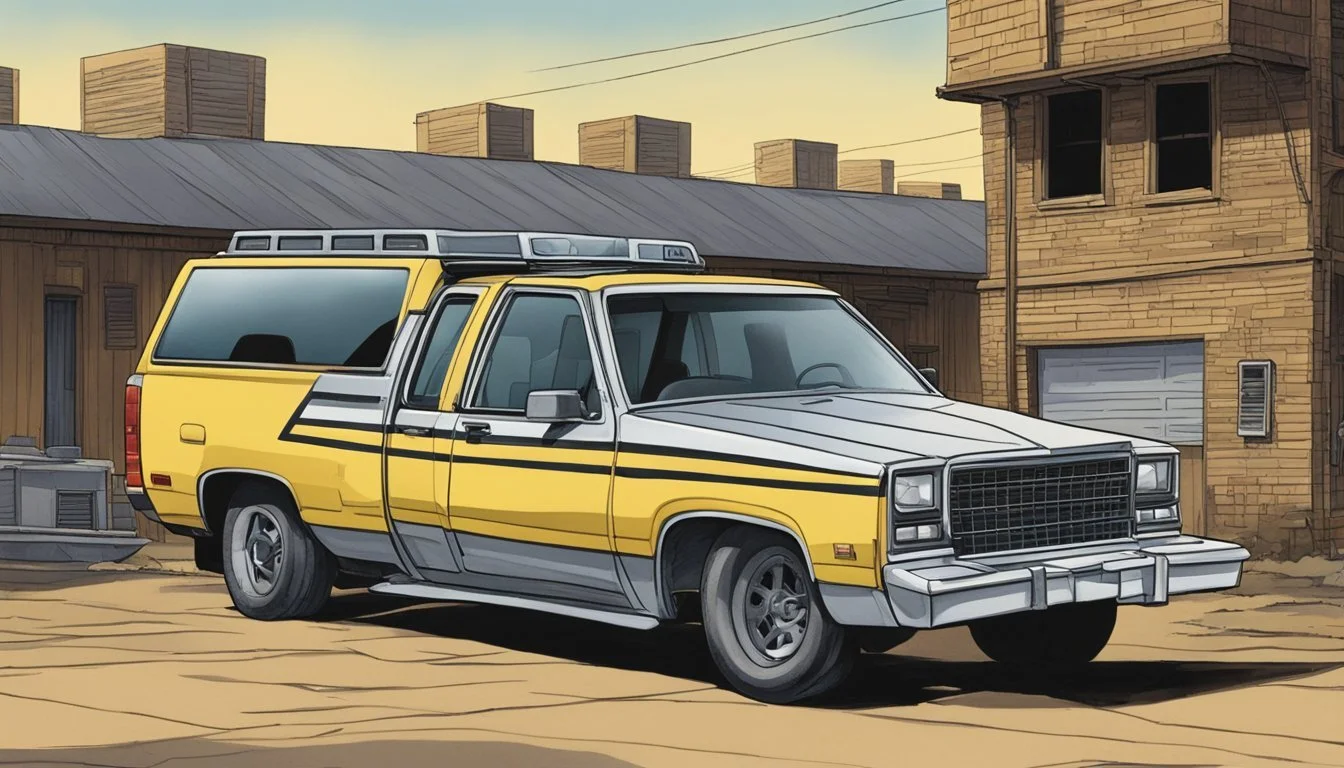13 Breaking Bad Moments That Made Us Question Our Own Morality
A Journey Through Ethical Dilemmas
Breaking Bad captivated audiences with its gripping narrative and complex characters, pushing the boundaries of television storytelling. The show's exploration of moral ambiguity and ethical dilemmas left viewers questioning their own values and beliefs.
Through Walter White's transformation from a mild-mannered chemistry teacher to a ruthless drug lord, Breaking Bad challenged viewers to examine the fine line between right and wrong. The series presented numerous moments that blurred the lines of morality, forcing audiences to confront uncomfortable truths about human nature and the consequences of choices made under difficult circumstances.
1) Walt Watches Jane Die
In a pivotal scene from Breaking Bad, Walter White stands by as Jesse's girlfriend Jane chokes on her own vomit. This moment marks a significant turning point for Walt's character and the series as a whole.
Jane's death occurs after she and Jesse indulge in heroin use. Walt enters Jesse's apartment to find them both unconscious. As Jane begins to choke, Walt hesitates, ultimately deciding not to intervene.
This scene forces viewers to confront their own moral boundaries. Walt's inaction raises questions about the extent of his transformation from a mild-mannered chemistry teacher to a ruthless drug lord.
The emotional weight of this scene is heightened by Bryan Cranston's nuanced performance. His facial expressions convey a complex mix of shock, contemplation, and resolve as he watches Jane struggle.
Walt's decision to let Jane die serves multiple purposes. It removes a potential threat to his operation and tightens his control over Jesse. This calculated move showcases the depths to which Walt is willing to sink for his own benefit.
2) Jesse Shoots Gale
Jesse Pinkman's decision to shoot Gale Boetticher marks a pivotal moment in Breaking Bad. This act occurs in the Season 3 finale, when Walt instructs Jesse to kill Gale to save their own lives.
The scene is tense and emotionally charged. Jesse arrives at Gale's apartment, visibly shaken and conflicted. Gale opens the door, unaware of the danger he faces.
With trembling hands, Jesse points the gun at Gale. The camera focuses on Jesse's anguished expression as he struggles with the weight of his actions. Gale pleads for his life, adding to the moral complexity of the situation.
Jesse ultimately pulls the trigger, forever altering the course of his life. This moment forces viewers to confront the limits of self-preservation and the consequences of choosing survival over morality.
The scene's impact is heightened by Aaron Paul's powerful performance as Jesse. His portrayal captures the character's inner turmoil and reluctance to cross this moral line.
Jesse's act of killing Gale serves as a turning point in his character development. It pushes him further down a dark path and intensifies the show's exploration of moral decay.
3) Skyler's Car Wash Scheme
Skyler White's plan to acquire the A1A Car Wash showcased her intelligence and resourcefulness. She identified the business as an ideal front for money laundering Walt's drug proceeds.
To pressure the owner into selling, Skyler orchestrated an elaborate ruse. She enlisted the help of Saul Goodman's associate, Patrick Kuby, to pose as an environmental inspector.
Kuby threatened to shut down the car wash, claiming its water was polluted. This clever tactic exploited the owner's fears and vulnerabilities, forcing him to consider selling the business.
Skyler's scheme raised ethical questions about using deception and manipulation for personal gain. It demonstrated her willingness to bend rules and exploit others to protect her family's interests.
The car wash scheme marked a turning point for Skyler. It showed her actively participating in Walt's criminal enterprise rather than merely being a reluctant bystander.
This moment challenged viewers to consider the lengths they might go to secure their family's financial future. It blurred the lines between right and wrong in pursuit of a perceived greater good.
4) Walt Poisons Brock
Walt's decision to poison Brock, a young boy, marked a significant moral turning point in Breaking Bad. This act shocked viewers and pushed the boundaries of what they thought Walt was capable of.
Brock was the son of Andrea, Jesse's girlfriend. Walt used a plant called Lily of the Valley to make Brock ill, manipulating Jesse into believing Gus was responsible.
The poisoning was calculated and deliberate. Walt's aim was to turn Jesse against Gus, using the child as a pawn in his dangerous game.
This moment forced viewers to confront the depths of Walt's moral decay. It demonstrated how far he had strayed from his initial motivations of providing for his family.
The poisoning of Brock highlighted Walt's willingness to harm an innocent child for his own gain. It showcased his ability to rationalize even the most reprehensible actions.
This event left many questioning if there were any lines Walt wouldn't cross in his pursuit of power and control. It solidified his transformation from a sympathetic character to a true villain.
5) Walt's Confession Tape
In a pivotal moment of Breaking Bad, Walter White creates a confession tape that shocks viewers and characters alike. This tape serves as a masterclass in manipulation and misdirection.
Walt fabricates an elaborate story implicating Hank as the true mastermind behind the drug empire. He portrays himself as a victim, coerced into manufacturing meth by his ruthless brother-in-law.
The confession tape showcases Bryan Cranston's exceptional acting skills. His performance perfectly captures Walt's calculated deception, blending false vulnerability with convincing lies.
This moment forces viewers to confront the depths of Walt's moral degradation. His willingness to destroy Hank's reputation and career demonstrates how far he's willing to go to protect himself.
The confession tape also highlights Walt's intelligence and foresight. He weaponizes the truth, twisting facts to create a plausible alternate narrative that threatens to unravel Hank's investigation.
This scene exemplifies Breaking Bad's exploration of moral ambiguity. It challenges viewers to question their sympathy for Walt and reconsider the boundaries of right and wrong in extreme circumstances.
6) Hank's Bathroom Discovery
Hank Schrader's life-changing revelation in Walter White's bathroom stands as a pivotal moment in Breaking Bad. While using the facilities at a family gathering, Hank stumbles upon a book of poetry that triggers a shocking realization.
The inscribed copy of Walt Whitman's "Leaves of Grass" catches Hank's eye. As he flips through the pages, he recognizes the handwriting from a case file he'd previously dismissed.
In an instant, the pieces fall into place. Hank connects his brother-in-law Walt to the elusive drug kingpin Heisenberg he's been chasing for months. This bathroom epiphany shatters Hank's world and sets in motion a dramatic chain of events.
The scene masterfully blends humor with tension. Hank's physical vulnerability on the toilet contrasts sharply with the weight of his discovery. His facial expressions convey the rollercoaster of emotions as the truth dawns on him.
This moment forces viewers to confront the consequences of Walt's actions. It raises questions about loyalty, justice, and the far-reaching impact of one's choices on family and society.
7) Gus Fring's Demise
Gus Fring's death in Breaking Bad was a pivotal moment that left viewers stunned. The meticulous drug lord met his end in a shocking explosion orchestrated by Walter White and Hector Salamanca.
The scene unfolded with Gus visiting Hector in the nursing home. Unbeknownst to him, a bomb was attached to Hector's wheelchair. As the bell rang and the explosion occurred, Gus emerged from the room seemingly unscathed.
For a brief moment, it appeared Gus had survived the blast. Then, the camera revealed half of his face had been blown off. He straightened his tie and collapsed, dead.
This scene challenged viewers' perceptions of mortality and justice. It raised questions about the nature of revenge and the consequences of a life dedicated to illegal pursuits.
Gus's death marked a turning point in the series. It eliminated a major antagonist and shifted the power dynamics of the drug world. The visual impact and unexpected nature of his demise made it one of the most memorable moments in television history.
8) The Train Heist
The train heist in Breaking Bad's "Dead Freight" episode stands as a masterclass in tension and moral ambiguity. Walt, Jesse, and Todd execute an intricate plan to steal methylamine from a moving train.
Their scheme involves precise timing and coordination to siphon the chemical without detection. The sequence builds suspense as unexpected complications arise, pushing the characters to their limits.
As the heist unfolds, viewers find themselves conflicted. On one hand, the technical brilliance and audacity of the plan are impressive. On the other, it's a stark reminder of how far Walt and Jesse have fallen into criminality.
The moment takes a dark turn when Todd shoots an innocent child who stumbled upon the scene. This shocking act forces the audience to confront the true cost of Walt and Jesse's actions.
The train heist encapsulates Breaking Bad's ability to create morally complex scenarios. It challenges viewers to examine their own ethical boundaries and question how far they would go in similar circumstances.
9) The Crawl Space Breakdown
Walt's descent into madness reaches a fever pitch in the crawl space scene. As he frantically searches for the money to pay the disappearer, he discovers most of it is gone.
Skyler's admission that she gave a large portion to Ted for his IRS fees pushes Walt over the edge. His maniacal laughter echoes through the house as he lies among the empty bags.
This moment forces viewers to confront the consequences of Walt's choices. His desperation and unhinged behavior reflect the toll his criminal life has taken on his psyche.
The claustrophobic setting of the crawl space amplifies the tension. Walt's inability to escape mirrors his trapped situation in the drug world he created.
As Skyler watches her husband's breakdown, we see the devastating impact on their family. Walt's actions have spiraled beyond his control, leaving a wake of destruction.
This scene serves as a turning point, solidifying Walt's transformation into Heisenberg. It challenges viewers to question how far they would go to protect themselves and their loved ones.
10) Jesse's Forced Relocation
Jesse Pinkman's forced relocation stands as a harrowing moment in Breaking Bad. After refusing to cook meth for the neo-Nazi gang, Jesse endures brutal captivity and coercion.
The gang imprisons Jesse in a concrete cell, chaining him like an animal. They force him to cook meth under threat of violence to himself and his loved ones.
This storyline pushes viewers to contemplate the lengths people might go to survive extreme circumstances. Jesse's torment and powerlessness evoke sympathy, while also raising questions about resilience and hope in dire situations.
His captors use psychological manipulation and physical abuse to break Jesse's spirit. This treatment blurs the lines between victim and perpetrator, as Jesse is forced to participate in illegal activities against his will.
The scenario challenges viewers to consider how they might act in Jesse's position. It prompts reflection on personal moral boundaries and the potential for compromise under duress.
11) The Prison Murders
Breaking Bad pushed moral boundaries to new extremes with the prison murders orchestrated by Walter White. In a calculated move, Walt arranged for the simultaneous killing of ten inmates across three different prisons.
The scene was brutal and methodical, showing the victims being stabbed repeatedly. This shocking display of violence demonstrated Walt's transformation into a ruthless criminal mastermind.
By eliminating these potential witnesses, Walt solidified his position at the top of the drug empire. The murders also highlighted the extent of his connections and influence within the criminal underworld.
This moment forced viewers to confront the depths of Walt's moral decay. It raised questions about the value of human life and the lengths one might go to protect their interests.
The prison murders marked a point of no return for Walt's character. They signaled his complete embrace of the Heisenberg persona and his willingness to sacrifice anyone who stood in his way.
12) Saul's Ethical Compromises
Saul Goodman's character arc in Breaking Bad exemplifies the gradual erosion of moral boundaries. As Walter White's lawyer, Saul repeatedly bends and breaks legal and ethical rules to serve his clients' interests.
Saul's willingness to facilitate money laundering and connect Walt with dangerous criminals demonstrates his disregard for professional ethics. He often prioritizes financial gain over legal and moral considerations.
The character's transformation from Jimmy McGill to Saul Goodman reflects a journey of moral compromise. Saul's actions become increasingly unethical as the series progresses, blurring the lines between legal counsel and criminal accomplice.
Saul's creative interpretation of the law and his manipulation of legal loopholes challenge viewers to consider the limits of attorney-client privilege. His behavior raises questions about the ethics of defending clients one knows to be guilty.
The character serves as a mirror to the audience, prompting reflection on how far one might go to protect self-interest or financial security. Saul's ethical compromises highlight the slippery slope of moral relativism in high-stakes situations.
13) Walt's Aztek as a Symbol
Walter White's Pontiac Aztek serves as a powerful symbol throughout Breaking Bad. The vehicle reflects Walt's transformation from an unassuming high school chemistry teacher to the notorious drug lord Heisenberg.
At the start of the series, the Aztek represents Walt's mundane suburban life. Its faded paint and mismatched wheel embody his unremarkable existence and unfulfilled potential.
As Walt descends into the criminal underworld, the Aztek takes on new meaning. Its damaged windshield mirrors Walt's increasingly clouded moral judgment and difficulty distinguishing right from wrong.
The car's gradual deterioration parallels Walt's own moral decay. Each dent and scratch represents another compromise of his ethics and descent into darkness.
When Walt finally disposes of the Aztek, it marks a significant turning point. He has fully embraced his Heisenberg persona and shed the last vestiges of his former self.
The Aztek's journey from family vehicle to battered wreck encapsulates Walt's dramatic arc. Its symbolic transformation resonates with viewers, making us question our own capacity for change and moral flexibility.
Moral Ambiguity in Breaking Bad
Breaking Bad masterfully explores the blurred lines between right and wrong through its complex characters and their questionable decisions. The show challenges viewers to examine their own moral compasses as they witness the gradual descent of its protagonists.
Evolution of Walter White
Walter White's transformation from a mild-mannered chemistry teacher to a ruthless drug kingpin epitomizes moral ambiguity. Initially driven by a desire to provide for his family after a terminal cancer diagnosis, Walt's actions become increasingly questionable.
He justifies manufacturing methamphetamine as a necessary evil, but his motivations shift over time. Walt's pride and ego take center stage as he embraces his alter ego, Heisenberg.
His choices lead to devastating consequences for those around him. The show forces viewers to grapple with the ethics of Walt's actions and question how far they might go in similar circumstances.
The Impact of Choices
Breaking Bad illustrates how seemingly small decisions can snowball into life-altering events. Characters often face moral dilemmas with no clear right answer.
Jesse Pinkman's struggle with guilt over his involvement in the drug trade highlights the psychological toll of morally ambiguous choices. Skyler White's complicity in her husband's criminal activities raises questions about loyalty and self-preservation.
The show presents scenarios where characters must choose between personal gain and ethical behavior. These situations mirror real-life challenges, prompting viewers to reflect on their own moral boundaries.
Breaking Bad's nuanced portrayal of human nature reminds us that morality is rarely black and white.
Character Development and Moral Conflict
Breaking Bad masterfully depicts characters grappling with complex ethical dilemmas. Their struggles and choices reveal the fine line between right and wrong, forcing viewers to examine their own moral boundaries.
Jesse Pinkman's Struggle
Jesse's journey from small-time drug dealer to conflicted partner in a criminal empire showcases profound character growth. His initial carefree attitude evolves into deep-seated guilt and trauma. Jesse faces impossible choices, like having to kill Gale to protect Walt and himself.
These pivotal moments test Jesse's conscience and humanity. He struggles to reconcile his actions with his innate empathy. This internal conflict manifests in self-destructive behavior and attempts at redemption.
Jesse's moral compass often clashes with Walt's increasingly ruthless methods. This tension drives much of the show's emotional impact.
Skyler White's Dilemmas
Skyler's character arc demonstrates the corrosive effect of Walt's decisions on his family. Initially unaware of Walt's criminal activities, she gradually becomes complicit.
Skyler faces difficult choices to protect her children and maintain a semblance of normalcy. She wrestles with the morality of money laundering and lying to her sister. Her attempts to rationalize these actions highlight the blurred lines between right and wrong.
As the truth about Walt unfolds, Skyler must confront her role in enabling his crimes. Her struggle to balance family loyalty with moral integrity creates compelling drama.






